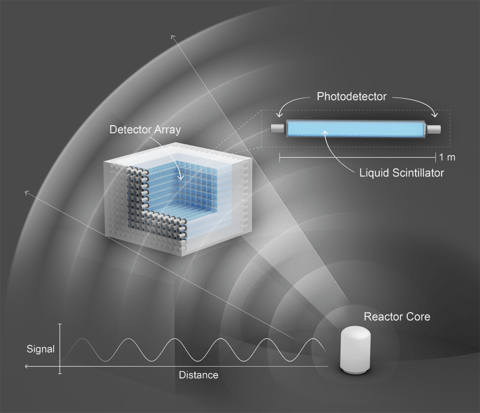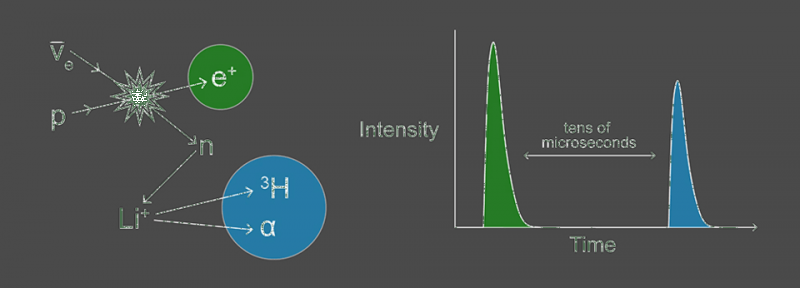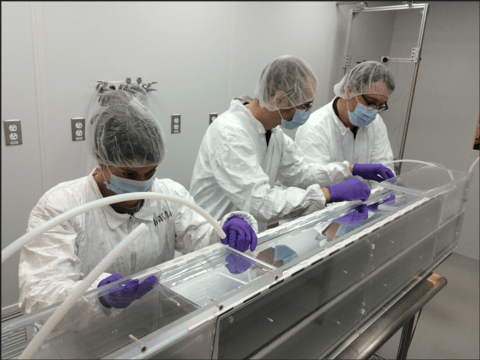In search of 'sterile' neutrinos

Lately, neutrinos – the tiny, nearly massless particles that many scientists study to better understand the fundamental workings of the universe – have been posing a problem for physicists.
They know that these particles are produced in immense numbers by nuclear reactions such as those taking place within our sun. They also know that neutrinos don't interact very often with matter; billions of them passed through your hand in the time it took you to read this sentence.
But in a host of experiments around the world, researchers are finding a deficit in the number of neutrinos they see versus what they expect to see, based on theory. And this has nothing to do with the shifting back and forth between the three flavors of neutrino that physicists also already know about.
One possible explanation is that there is a fourth kind of neutrino that hasn't been detected. It's referred to as a sterile neutrino. And NIST scientists will begin looking for it next year as part of the Precision Oscillation and Spectrum Experiment (PROSPECT), a collaboration involving 68 scientists and engineers from 10 universities and four national laboratories.
"This is potentially a discovery experiment," says NIST's Pieter Mumm, who is a co-founder and co-spokesperson for the project, along with Karsten Heeger at Yale University and Nathaniel Bowden at Lawrence Livermore National Laboratory. Discovering a new particle would be "super exciting," he continues, because a new type of neutrino is not part of the Standard Model of physics, the well-vetted explanation for the universe as we know it.
To find the new particle or definitively disprove its existence, the PROSPECT collaboration is preparing to build a first-of-its-kind detector for short-range neutrino experiments, using a nuclear reactor as the neutrino source.

The work could not only shed light on new physics, but it could also give researchers a new tool to monitor and safeguard nuclear reactors.
PROSPECTing for Neutrinos
Unlike other neutrino experiments, which typically look at the oscillations between the three known flavors over distances of kilometers or hundreds of kilometers, PROSPECT will look at neutrino oscillations over just a few meters, the space of a small room. The distance is too short to see oscillations between the known flavors. But it is exactly the right scale for the hypothesized sterile neutrino oscillations.
This setup "gives you a signature that's absolutely iron-clad," Mumm says. "If you see that variation, that characteristic oscillation, there is only one explanation for it. It has to be sterile neutrinos."
The detector itself will be about 4.5 meters cubed and will be composed of an 11-by-14 array of long skinny "cells" stacked on each other [see diagram], with an expected spatial resolution of about 10 cubic centimeters. As its source for neutrinos, PROSPECT will use the High Flux Isotope Reactor at Oak Ridge Laboratory in Tennessee. The experiment will be placed as close as possible to the reactor core itself – only 7 meters (about 20 feet) away.
PROSPECT will not see the sterile neutrinos directly. Rather, it will detect a particular kind of neutrino that is regularly produced in nuclear reactors: the electron-type antineutrino.

To identify an electron antineutrino, the researchers will look for a particular signal in light. Each cell in the detector is filled with a scintillating material. That means that energy is converted to light, which is amplified and picked up by a pair of photomultiplier tubes on each cell.
When a neutrino hits a proton in the liquid filling the cells, it creates new particles that deposit energy within the detector. These daughter particles form a signature that tells researchers that a neutrino was once there (see diagram above).
"What we're actually sensing is the light emitted by the liquid scintillator," Mumm says. The signal that they are looking for is "something that looks like a positron, followed at the appropriate time [tens of microseconds, or millionths of a second] by something that looks like a neutron capture."
Next Steps
So far, the collaboration has created a series of prototypes, including a pair of cells built to scale, and is running simulations to validate the models they are using to separate the signal from the high backgrounds they expect. Thanks to grants from the U.S. Department of Energy and the Heising-Simons Foundation this summer, they have begun to physically build the detector.
PROSPECT should answer the question of whether there are sterile neutrinos or not within three years, Mumm says. Meanwhile, the collaboration's work has some potentially game-changing spin-offs for reactor physics. For example, scientists could potentially use this technology to engineer a device to monitor reactor operations remotely.
"You can imagine, at least it seems to me, that this could be a pretty powerful tool in the right circumstances," Mumm says. "You can't shield neutrinos. There's no way to spoof it."
Provided by National Institute of Standards and Technology




















